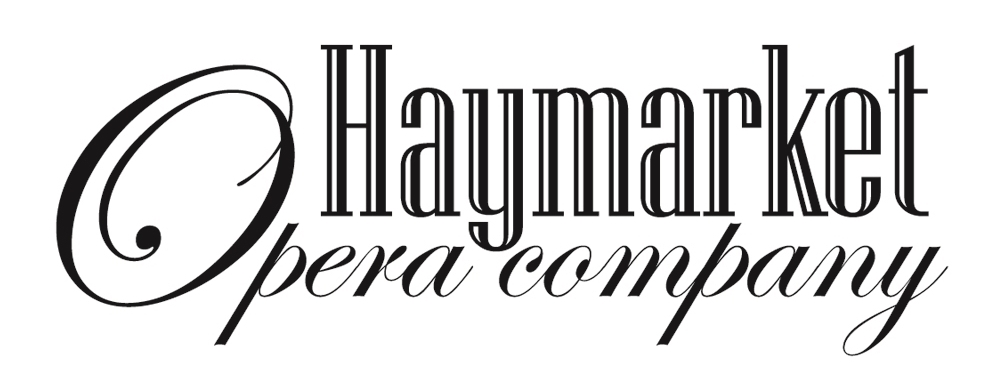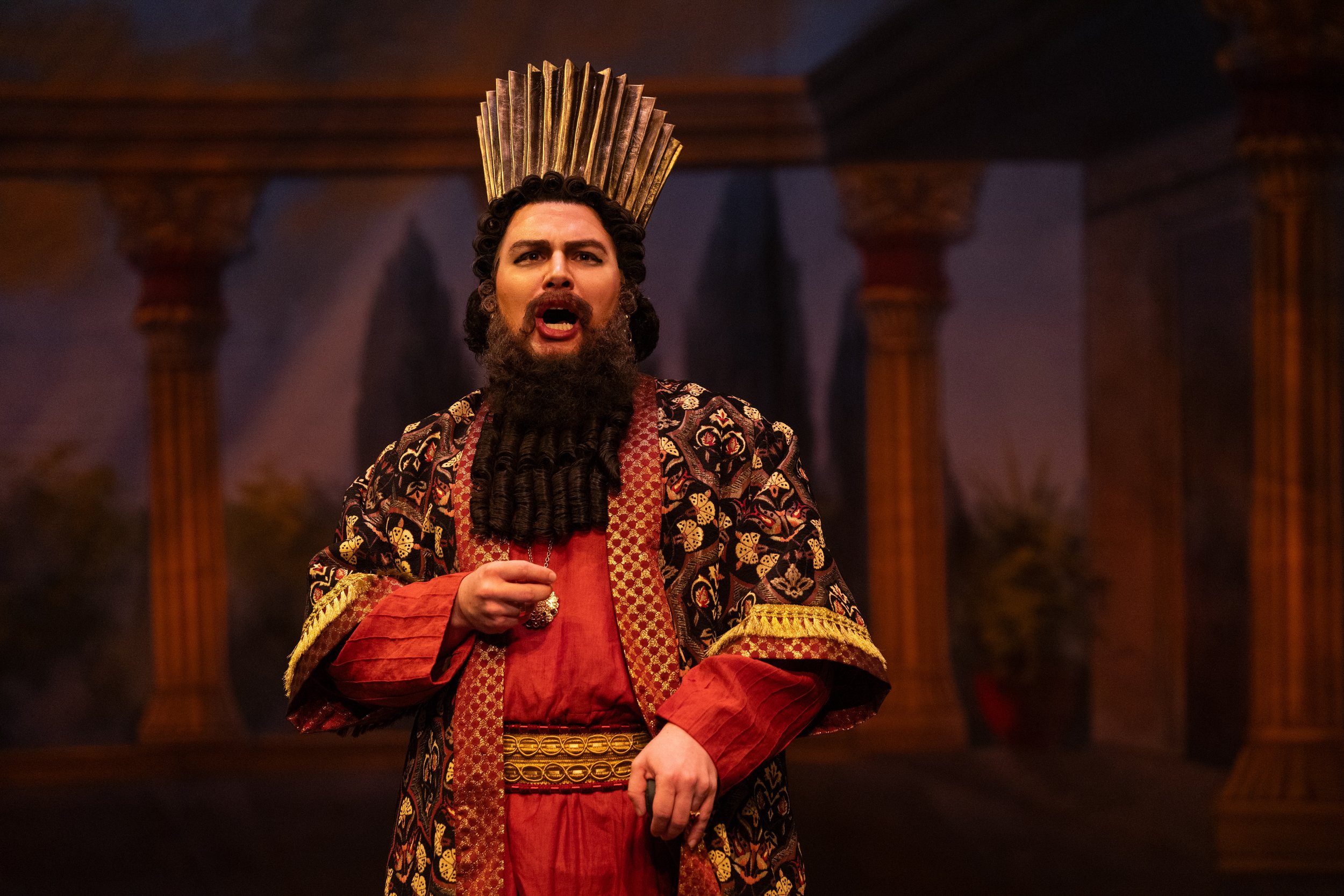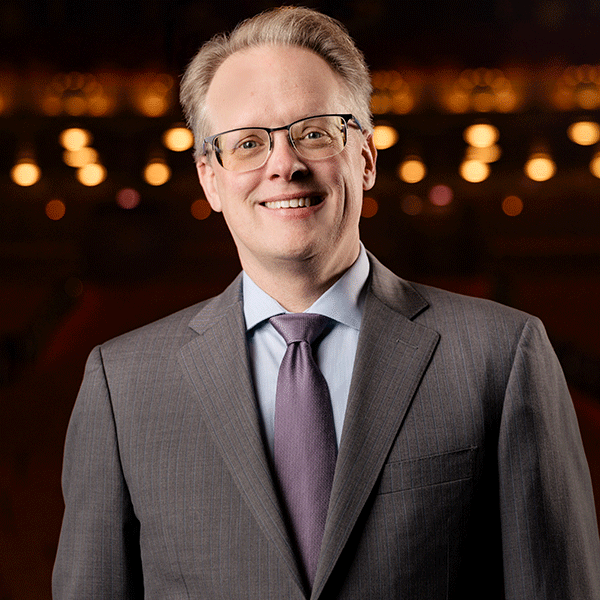John Mangum, General Director, President & CEO of Lyric Opera of Chicago. Photo: Kyle Flubacker
Lyric Opera of Chicago General Director John Mangum on Vinci’s Artaserse at Haymarket
When Chase invited me to share some reflections on Haymarket Opera’s production of Leonardo Vinci’s Artaserse, I was more than happy to accept. Before coming to Lyric in October 2024, I worked at orchestras for nearly 30 years. While the august philharmonics and symphony orchestras of our nation’s major cities do occasionally venture into the musical Paleozoic of the decades before Mozart—filled with life, much of it vaguely alien to many modern ears—those outings are rare.
I love the pre-classical repertoire; it was the focus of my academic work before going into the performing arts. Specifically, I studied the operas of Johann Adolph Hasse and Carl Heinrich Graun, both slightly younger contemporaries of Leonardo Vinci who were profoundly influenced by the Neapolitan brand of opera seria (which they called dramma per musica—a “play for music”) that Vinci represented. Their operas formed a sort of canon at the Prussian court opera in Berlin, dominating the repertoire there for the nearly five decades of Frederick the Great’s reign in the second half of the 18th century. When other cities had moved on to the classical style of Mozart, Haydn, and their peers, Berlin clung to an older tradition, one with roots in Naples during the first decades of the 1700s, when the Enlightenment had yet to pose its questions to the ancien régime, and Metastasio’s tales of the amours and intrigues of Roman emperors and mythological characters reigned supreme.
Portrait of Pietro Metastasio by Martin van Meytens (1770)
One of the misconceptions about the 18th century before Mozart and Haydn is that there was no canon—that the canon starts with the classical style and its blossoming in 1780s Vienna. Before that, musical canon was less important, though there are examples throughout the 18th century of works taking the continent by storm—think of Vivaldi’s string concertos finding their way to Bach, then Kapellmeister in Weimar, to become brilliant organ and keyboard solos. What mattered was the literary canon, and at the center of this poetic solar system shone the sun that was Pietro Metastasio.
Original libretto cover for Johann Adolph Hasse's 1730 setting of Artaserse (1730)
Artaserse is a perfect example of what I mean. Metastasio wrote this “play for music” in close collaboration with Vinci. Vinci’s opera was the first of something like 90 different settings of the text. These included versions by Hasse (1730, the same year as Vinci’s; as well as substantially revised versions in 1740 and 1760) and Graun (1743). All three of Hasse’s versions featured one of the greatest hits of the day, Artabano’s aria “Pallido il sole,” which castratos took up with enthusiasm; both Caffarelli and Farinelli included it in pasticcios devised specifically to show off their remarkable voices. Metastasio’s text even made its way to England, where Thomas Arne translated and adapted it for his Artaxerxes (1762). This work managed to hold the stage after its Covent Garden premiere until the 1830s, and it has had occasional revivals since. Mandane’s aria “The Soldier Tir’d” opens one of the most famous recital records ever made, Joan Sutherland’s Art of the Prima Donna, making it immediately clear, to me at least, why the work reigned in London for nearly eight decades.
All of this is to say that your Artaserse journey need not stop with Haymarket’s performances of the Vinci setting. Metastasio’s text was central to the pre-classical operatic canon, and many composers of great skill set some version of the text once it made its way into the world after Vinci’s had its premiere in February 1730. Many of these works have also been recorded, or filmed, or both, meaning there are hours upon hours of Artserses waiting for you to discover.
Eric Ferring in Artaserse. Photo: Elliot Mandel
It was fascinating to hear Haymarket’s dedicated and invigorating performance of Vinci’s setting of Metastasio’s text, likely the first ever in the United States and one of the few productions since 1730. The first thing that struck me was that there was a lot of play around gender in the production—we had Ryan Opera Center alumna Emily Fons singing a role originally written for a soprano castrato, and we had the remarkable male soprano Elijah McCormack in the role of Semira, Arbace’s sister. This, of course, was totally in keeping with what we would have experienced in Rome nearly 300 years ago, when the cast of Vinci’s Artaserse (or should we be saying Metastasio’s Artaserse in deference to the literary, rather than the musical, canon?) was all male. This was thanks to Pope Sixtus V, who banned women from appearing on stage in the Papal States and their capital, Rome. (The ban on women singing in church has its earliest documented origins in the sixth century, with the synod of Auxerre.) The castrato, which emerged as a voice-type in Italy in the 16th century, gave Vinci and his fellow composers working in Rome the ability to employ a wider range of voices in opera, oratorio, and sacred music.
Another thing that struck me is that, at least in this production, the center of gravity for the drama was not the title character. Artabano, performed with intensity by another Ryan Opera Center alum, tenor Eric Ferring, was at the center of the drama, at least for me. The friendship between Artaserse and Arbace, Artabano’s son, was another important vector, but Artabano mediated their relationship, manipulating both to try to achieve his desired outcome (wanting Arbace to become king, and eventually trying to poison Artaserse) over the opera’s course.
Key’mon Murrah and Emily Fons in Artaserse (2025). Photo: Elliot Mandel
Hearing a nearly complete performance drove home how alien Metastasio’s dramaturgy is to our own times. He’d never get a Netflix deal with this stuff. It is formal, stilted, moves at a stately pace—and that’s being kind—until he breathlessly resolves everything in a matter of moments. But Metastasio wasn’t aiming for verisimilitude; he was reinforcing the world order in a Europe dominated by various forms of absolute monarchy, showing that the ruler was wise, just, and merciful, and would get everything sorted out in the end. He was also creating a vast scaffolding on which a composer of genius such as Vinci could drape his art. The recitatives are where the action happens; the arias provide long-breathed moments for reflection, often using similes that provide inspiration to the composer for vivid musical picture-painting. The vivid aria “Vo solcando un mar crudele” that closes Act I — a moment of power and depth, with its depiction of a stormy sea as metaphor for Arbace’s tortured state—brought the house down in Rome, where it was sung by the legendary Carestini; it did the same in Chicago, where countertenor Key’mon W. Murrah gave a stunning performance in the number, and in his role.
And that’s at the heart of what an audience came for in Vinci’s day: the singers. Carestini, Farinelli, Sensino, Faustina, Durastanti—these names would have been familiar to every music lover circa 1730, and the chance to hear them in an opera by Vinci or Handel was a peak musical experience. Impresarios and courts paid dearly for these stars. In Berlin, Carestini earned twenty times as a star soloist what C.P.E. Bach made as one of Frederick the Great’s court composers and the keyboardist in his orchestra. Of Farinelli, the great diarist and music historian Charles Burney wrote, “Farinelli could hold his notes for such a long time that those who heard him believe that it was impossible to do so naturally. They believed he hid a special instrument which maintained the sound of his voice whilst he took another breath.” It was to hear this “supernatural” singing that audiences flocked to opera houses in the first half of the 18th century. The superlative singing in Haymarket’s Artaserse paid ample and appropriate tribute to that.
I also enjoyed seeing so many new and old friends at the performance. Several Chicago opera lovers, whom I’ve gotten to know from Lyric, were there to enjoy the experience. And a wonderful colleague from Houston, Matthew Dirst, was at the keyboard for the performance. It was another reminder that the world is small, that people who love opera seek it out wherever they can (I just ran into two Lyric patrons at the Opera Festival in Munich, after having traveled with a group of supporters of our Ryan Opera Center to Aix-en-Provence), and that Chicago’s vibrant opera ecosystem thrives when Lyric, Haymarket, and all of the other companies that comprise it take bold artistic steps. Artaserse was certainly that for Chicago—a likely American premiere, with a great cast and what one audience member thought was the largest orchestra in the pit Haymarket had ever fielded for one of its productions. I, for one, won’t forget the experience.
Learn more about Haymarket’s 2025 performance of Vinci’s Artaserse.
About the author
John Mangum is the General Director, President & CEO of Lyric Opera of Chicago, the fifth in the company’s history. Having joined Lyric in the fall of 2024, he brings more than two decades of leadership experience in the arts, most recently as Executive Director/CEO of the Houston Symphony, where he served from 2018 to 2024.
During his tenure at Houston, the organization raised significant funds to renovate its hall, strengthened its balance sheet by $60 million, appointed a new music director, and performed in-person and virtually for more than 1.1 million people during the pandemic season.
Mangum grew up in the San Francisco Bay Area and began his career at the Los Angeles Philharmonic. He subsequently held senior artistic planning roles at several of the country’s leading orchestras — the San Francisco Symphony, the New York Philharmonic, and the Saint Paul Chamber Orchestra. Major initiatives at these orchestras included concert stagings of Fidelio, Peter Grimes, Bluebeard’s Castle, Ligeti’s Le Grand Macabre, John Cage’s Song Books, West Side Story, Company, and Amadeus. He also served as President and Artistic Director of the Philharmonic Society of Orange County, overseeing all aspects of the Society’s operations, including the successful completion of its first-ever endowment campaign.
Mangum is an alumnus of the Impact Program for Arts Leaders at Stanford’s Graduate School of Business. He holds a Ph.D. in history with a concentration in musicology, in addition to master’s and bachelor’s degrees in history, from the University of California, Los Angeles. His scholarly work looks at the intersection of Italian opera and political power in 18th century German-speaking Central Europe.
About The Haymarket Review: This new digital publication including thoughts about the work produced by Haymarket is designed to deepen our connection to audiences, nurture and feed audience curiosity about historical performance, offer critical opinions and thoughtful reflections on our performances, and provide a forum for Haymarket and its audience to connect through sharing insights, opinions, learning, and expertise.







